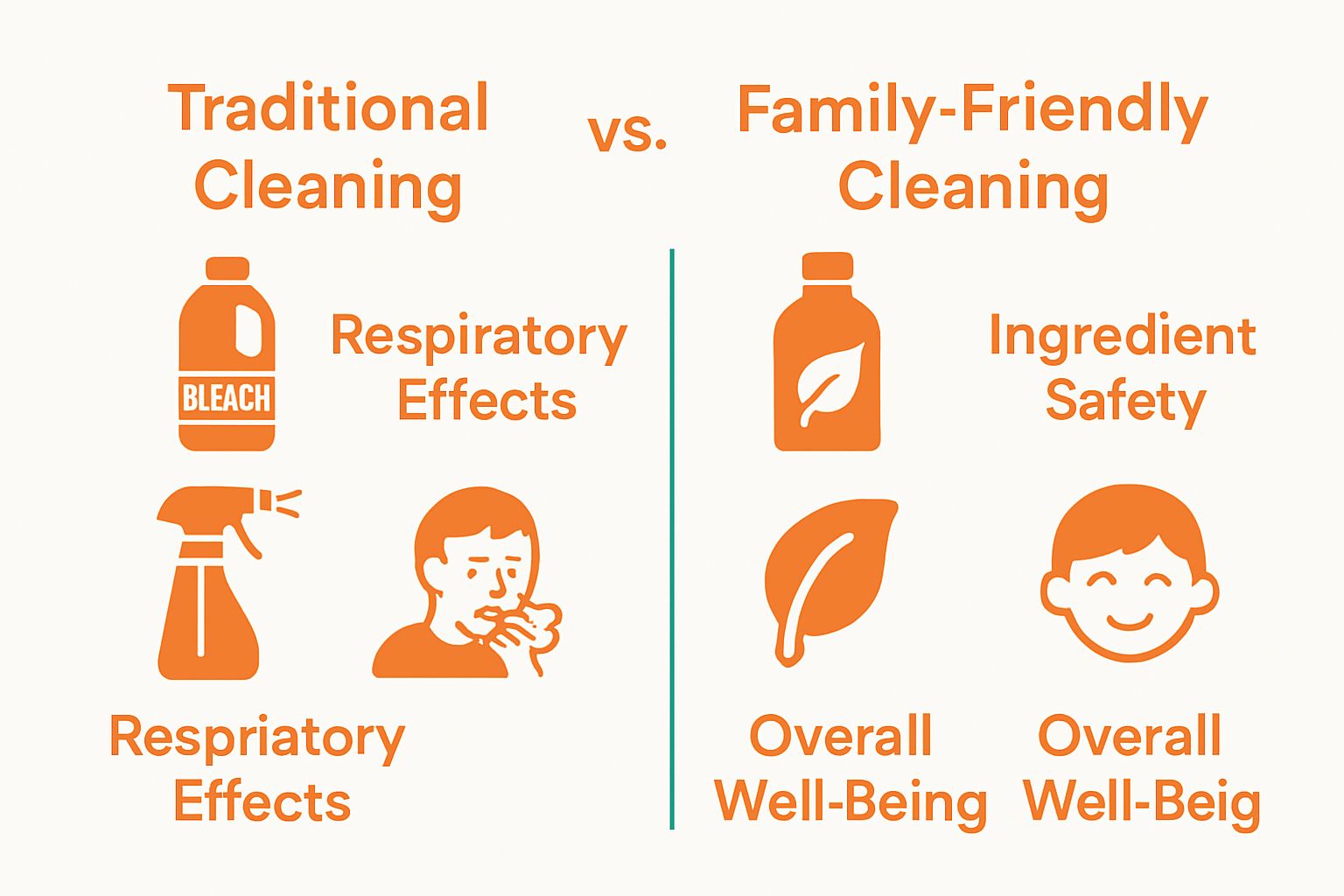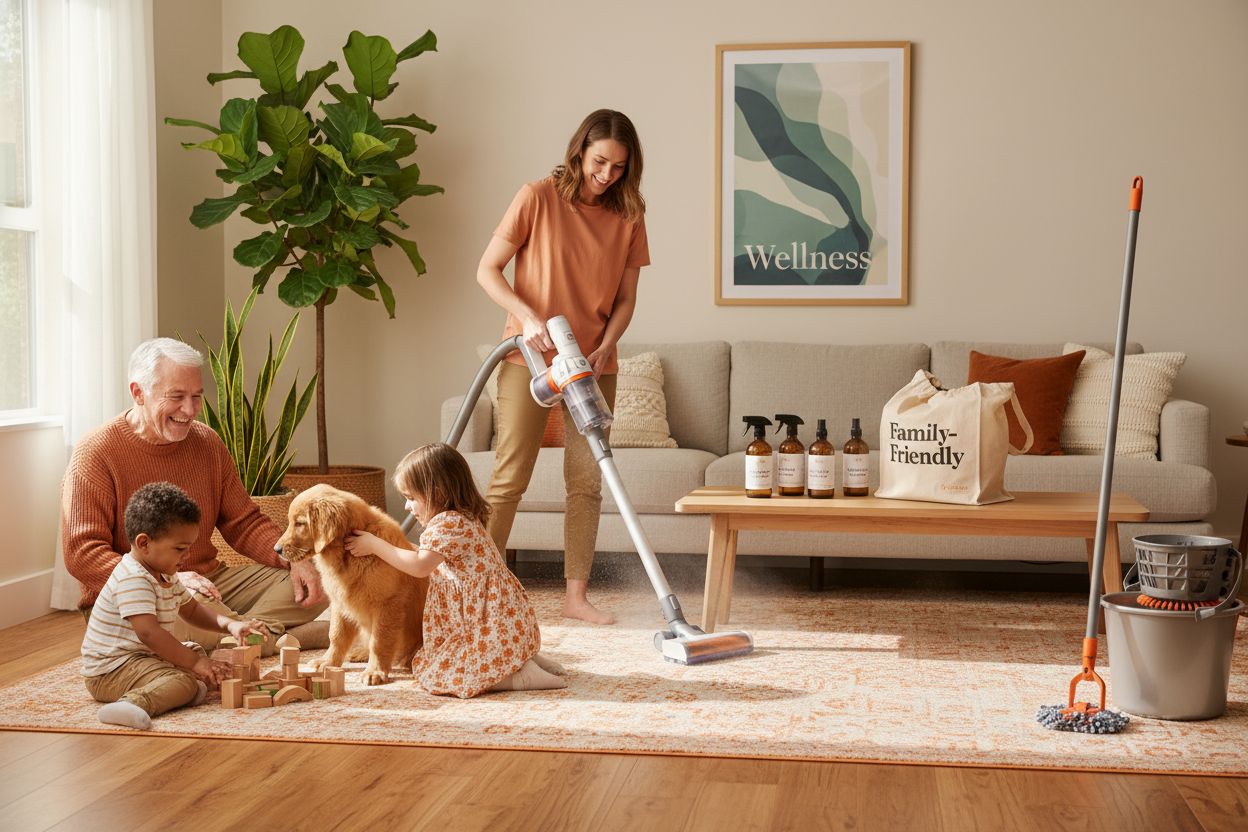Family-friendly cleaning is catching on fast with parents and caregivers who want more than just a spotless home. You might think switching out traditional cleaners means sacrificing results or spending more money. Yet over 47 percent of families now choose products with non-toxic ingredients that are proven to be just as effective as the old chemical-heavy stuff. This shift is changing what a healthy home really means.
Table of Contents
- Defining Family-Friendly Cleaning: Key Characteristics
- The Importance Of Family-Friendly Cleaning For Health
- Understanding Safe Cleaning Products And Their Impact
- How To Create A Family-Friendly Cleaning Routine
- Real-World Applications Of Family-Friendly Cleaning
Quick Summary
| Takeaway | Explanation |
|---|---|
| Prioritize non-toxic cleaning products | Choose products with non-toxic ingredients to protect your family’s health. Avoid traditional cleaning chemicals that can cause health issues. |
| Implement a structured cleaning routine | Develop a cleaning schedule that identifies high-traffic areas and assigns age-appropriate tasks to family members. This enhances safety and effectiveness. |
| Educate family members about safe practices | Teach proper cleaning techniques and the importance of avoiding harmful chemicals. This fosters a culture of health awareness within the household. |
| Focus on hypoallergenic solutions | Use hypoallergenic cleaning products to reduce the risk of respiratory issues, especially for sensitive individuals in your household. |
| Consider environmental impacts of cleaning | Select biodegradable cleaning products to minimize ecological harm and support sustainability while maintaining a clean home environment. |
Defining Family-Friendly Cleaning: Key Characteristics
Family-friendly cleaning represents a holistic approach to maintaining a healthy home environment that prioritizes safety, effectiveness, and minimal risk to household members. Unlike traditional cleaning methods that often rely on harsh chemicals, this approach focuses on solutions that protect the well-being of children, pets, and individuals with sensitive health conditions.
Understanding Safe Cleaning Principles
At its core, family-friendly cleaning involves selecting products and techniques that eliminate potential health hazards while effectively removing dirt, bacteria, and grime. The US Environmental Protection Agency’s Safer Choice program provides critical guidance on identifying cleaning solutions that meet stringent safety standards.
Key characteristics of family-friendly cleaning include:
- Non-toxic ingredients that do not produce harmful fumes or residues
- Hypoallergenic formulations designed to minimize respiratory irritation
- Environmentally sustainable production methods
- Transparent labeling that clearly communicates product composition
Chemical Safety and Health Considerations
Traditional cleaning products often contain potentially harmful substances like ammonia, chlorine bleach, and volatile organic compounds (VOCs). These chemicals can trigger respiratory issues, skin irritations, and long-term health complications. Family-friendly cleaning solutions prioritize natural, biodegradable ingredients that deliver powerful cleaning performance without compromising household health.

The approach goes beyond simply selecting safer products. It encompasses a comprehensive strategy that includes proper ventilation, appropriate application techniques, and understanding potential interactions between different cleaning agents. This mindful methodology ensures that cleaning becomes a process of nurturing and protecting your living space, rather than introducing additional health risks.
By embracing family-friendly cleaning principles, households can create healthier environments that support overall well-being while maintaining high standards of cleanliness and hygiene.
Below is a table comparing traditional cleaning products and family-friendly cleaning solutions, highlighting their key characteristics and health impacts.
| Aspect | Traditional Cleaning Products | Family-Friendly Cleaning Solutions |
|---|---|---|
| Main Ingredients | Harsh chemicals (e.g., ammonia, VOCs) | Non-toxic, natural, or biodegradable |
| Health Risks | Respiratory issues, skin irritation | Minimized health risks |
| Environmental Impact | High pollution, non-biodegradable | Lower pollution, biodegradable |
| Label Transparency | Often unclear | Clear, transparent labeling |
| Hypoallergenic Options | Rare | Common |
| Impact on Vulnerable Members | Higher risk for children, elderly | Designed for sensitive individuals |
| Production Methods | Conventional, less sustainable | Environmentally sustainable |
The Importance of Family-Friendly Cleaning for Health
Healthy living environments extend far beyond aesthetic cleanliness, encompassing a comprehensive approach that directly impacts human wellness. Family-friendly cleaning represents a critical strategy for protecting household members from potential health risks associated with traditional cleaning practices.
Long-Term Health Implications of Cleaning Practices
Traditional cleaning methods often expose families to numerous invisible health hazards. Research from the National Institutes of Health reveals that prolonged exposure to harsh chemical cleaning agents can significantly increase risks of respiratory disorders, allergies, and chronic health conditions.
Critical health risks associated with conventional cleaning include:
- Respiratory system damage from volatile organic compounds
- Skin irritation and dermatological complications
- Potential neurological impacts from chemical exposure
- Increased risk of developing chronic respiratory conditions
Protecting Vulnerable Household Members
Children, elderly individuals, and those with pre-existing health conditions are particularly susceptible to cleaning-related health challenges. Their developing or compromised immune systems make them more vulnerable to chemical interactions. Family-friendly cleaning approaches prioritize creating safe, nurturing environments that minimize potential health threats.
The strategy involves more than product selection. It requires a holistic understanding of how cleaning agents interact with living spaces, human biology, and environmental systems. This comprehensive approach considers not just immediate cleaning effectiveness, but long-term health implications for every household member.
By adopting family-friendly cleaning practices, households can transform their living spaces into genuine wellness environments. These methods go beyond surface-level hygiene, addressing deeper health considerations and creating spaces that actively support physical well-being and protection.
Understanding Safe Cleaning Products and Their Impact
Safe cleaning products represent a critical evolution in household maintenance, transforming how families approach cleanliness and health protection. These innovative solutions prioritize human and environmental well-being without compromising cleaning effectiveness.
Identifying Characteristics of Safe Cleaning Solutions
Safe cleaning products distinguish themselves through comprehensive safety profiles that extend beyond basic cleaning performance. Environmental researchers from the Australian Government highlight the importance of selecting products that minimize chemical pollution and protect household ecosystems.
Key indicators of safe cleaning products include:
- Natural and biodegradable ingredient compositions
- Minimal volatile organic compound (VOC) emissions
- Transparent ingredient labeling
- Certifications from recognized environmental and health organizations
Environmental and Health Considerations
Beyond immediate cleaning needs, safe cleaning products play a significant role in reducing environmental contamination and protecting human health. These products are engineered to break down quickly, minimize water pollution, and reduce the ecological footprint associated with traditional cleaning chemicals.
The selection process involves carefully evaluating product ingredients, understanding their potential interactions, and assessing their long-term environmental impact. Manufacturers of safe cleaning solutions invest substantial research into developing formulations that effectively clean surfaces while maintaining strict safety standards for human and environmental health.
By choosing safe cleaning products, households contribute to a broader ecosystem of sustainability.
This table summarizes the most notable features to look for in safe cleaning products and explains their significance for a healthy home.
| Feature | Description |
|---|---|
| Non-toxic Ingredients | Do not produce harmful fumes or residues |
| Hypoallergenic Formulation | Minimizes risk of respiratory irritation |
| Environmentally Sustainable | Uses biodegradable, eco-friendly production methods |
| Transparent Labeling | Clearly lists product composition and safety info |
| Certified by Health Agencies | Recognized by organizations for meeting safety standards |
| Minimal VOC Emissions | Reduces release of harmful airborne chemicals |
| Suitable for Sensitive Groups | Designed for children, elderly, and those with sensitivities |
How to Create a Family-Friendly Cleaning Routine
Developing a family-friendly cleaning routine requires strategic planning that balances effectiveness, safety, and efficiency. This approach transforms cleaning from a potential health risk into a systematic process that protects and nurtures household wellness.
Foundational Planning for Safe Cleaning
The Centers for Disease Control and Prevention emphasizes the importance of creating structured cleaning protocols that minimize chemical exposure while maintaining rigorous hygiene standards. A thoughtful routine begins with understanding your household’s unique needs and potential sensitivities.
Key considerations for establishing a family-friendly cleaning routine include:
- Identifying high-traffic and high-contamination zones
- Selecting age-appropriate cleaning responsibilities
- Creating a consistent cleaning schedule
- Investing in safe, multifunctional cleaning tools
Implementing Safe Cleaning Practices
Successful family-friendly cleaning goes beyond product selection. It involves teaching household members about proper cleaning techniques, understanding product interactions, and developing habits that reduce overall chemical exposure. This holistic approach transforms cleaning from a chore into an educational opportunity that promotes health awareness.
The routine must be adaptable, recognizing that different areas of the home require varied approaches. Kitchen surfaces demand different cleaning strategies compared to bathroom environments. By developing zone-specific protocols, families can optimize their cleaning effectiveness while maintaining a comprehensive safety framework.
Ultimately, a family-friendly cleaning routine is a dynamic system that evolves with household needs. It requires ongoing communication, periodic reassessment of cleaning products, and a commitment to creating a safe, healthy living environment that supports the well-being of all household members.

Real-World Applications of Family-Friendly Cleaning
Family-friendly cleaning transcends theoretical concepts, offering practical strategies that can be implemented across diverse household and professional environments. These approaches demonstrate how safety and effectiveness can coexist in real-world cleaning scenarios.
Residential Implementation Strategies
Research from the American Cleaning Institute reveals that comprehensive family-friendly cleaning strategies can significantly reduce household chemical exposure while maintaining optimal hygiene standards. Residential environments provide an ideal testing ground for integrating safer cleaning methodologies.
Key residential application areas include:
- Nurseries and children’s play spaces
- Kitchen and food preparation areas
- Shared living spaces with high traffic
- Households with individuals with respiratory sensitivities
Professional and Institutional Cleaning Contexts
Beyond home environments, family-friendly cleaning principles are increasingly adopted in professional settings such as schools, healthcare facilities, and office spaces. These contexts require robust cleaning approaches that balance effectiveness, safety, and environmental responsibility.
Institutional cleaning programs leveraging family-friendly methods prioritize comprehensive protection strategies. They focus on selecting cleaning agents that minimize potential health risks while delivering thorough sanitization. This approach involves careful product selection, staff training, and developing protocols that reduce chemical exposure without compromising cleaning standards.
By embracing family-friendly cleaning principles across residential and professional domains, organizations and households can create safer, healthier environments that protect human well-being and support sustainable practices.
Discover Cleaner, Safer Living for Your Whole Family
If you are concerned about harsh chemicals and want to create a safe environment for your children and loved ones, you are not alone. The article highlights how traditional cleaning products can expose your family to lingering toxins and undesirable health risks. You deserve a cleaning solution that is both effective and family-friendly. DreamRamp.ro addresses these exact needs by offering a variety of innovative cleaning equipment that is designed for safe everyday use. Our range includes electric and manual mops, practical buckets, ergonomic brushes, and smart accessories, all created to help you maintain a hygienic home without the danger of harsh chemicals. Experience the difference of cleaning tools that prioritize safety and quality. Want to see how easy it can be to protect your household?

Take action now for a safer home. Browse our complete lineup at DreamRamp.ro and discover cleaning sets that keep clean water separate from dirty water. Shop today and bring peace of mind to your cleaning routine. Your family deserves pure comfort and a healthy indoor space.
Frequently Asked Questions
What is family-friendly cleaning?
Family-friendly cleaning is an approach to maintaining a safe home environment by using non-toxic and effective cleaning products that minimize health risks, especially for children, pets, and individuals with sensitive health conditions.
What characteristics should I look for in safe cleaning products?
When choosing safe cleaning products, look for non-toxic ingredients, hypoallergenic formulations, environmentally sustainable production methods, and transparent labeling that clearly communicates product composition.
How can I create a family-friendly cleaning routine?
To create a family-friendly cleaning routine, identify high-traffic areas, assign age-appropriate cleaning tasks, develop a consistent schedule, and invest in safe, multifunctional cleaning tools to reduce chemical exposure while ensuring effective cleaning.
What are the health risks associated with traditional cleaning products?
Traditional cleaning products can contain harmful substances like ammonia and volatile organic compounds (VOCs), increasing the risk of respiratory issues, skin irritations, and long-term health complications for household members, particularly children and those with existing health conditions.









